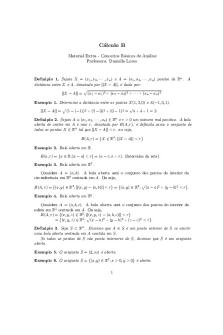Lectures 11 and 12 - Extra material included that is not required to meet the learning outcomes PDF

| Title | Lectures 11 and 12 - Extra material included that is not required to meet the learning outcomes |
|---|---|
| Course | Biochemistry |
| Institution | King's College London |
| Pages | 2 |
| File Size | 83.1 KB |
| File Type | |
| Total Downloads | 28 |
| Total Views | 143 |
Summary
Download Lectures 11 and 12 - Extra material included that is not required to meet the learning outcomes PDF
Description
The following material is included in Lectures 11 and 12 but is ‘extra’ material added for interest or to help you understand the concepts. You do not need to learn this material to meet the Learning Outcomes of the lectures
1. Rate enhancements by selected enzymes (slide 7) are for illustration only, not to memorize. 2. Enzyme mechanism for chymotrypsin. (Will be covered next term in the Chemistry module) (Slides 22 – 28). You should understand the basis for specificity of chymotrypsin (hydrophobic pocket) and that the class it belongs to ‘serine protease’ refers to serine in the enzyme structure forming part of its catalytic mechanism. Details of the mechanism are not required until next term. 3. Derivation of the Michaelis-Menten equation. You should understand the steady state approximation shown on slide 30 and you do need to know the MichaelisMenten equation and understand the terms in it, but you do not need to be able to reproduce the derivation. The material in the pink boxes on slide 31 is what you should be able to reproduce and relate to the reaction scheme:
4. Eadie-Hofstee and Hanes plots (slide 36). You should understand the MichaelisMenten and Lineweaver-Burk plots, know what is plotted on each axis and know how to use them to derive Km and Vmax. You do not need to memorise details of the Eadie-Hofstee and Hanes plots. 5. Km values of some enzymes (slide 38) are for illustration only, not to memorize. 6. Kcat and Ka (slide 39) – you should understand the equations and the kind of information these constants can give about an enzyme, but you do not need to memorize the full definitions of these constants. 7. Turnover numbers of some enzymes (slide 40) are for illustration only, not to memorize.
8. Chymotrypsin mechanism (again) (Slide 41 and 42) 9. Arrhenius equation for dependence of reaction rate on temperature. (Slide 44). You should understand the basic principles of the effect of temperature on reaction rates, but if you have not studied the Arrhenius equation before you do not need to learn it now. 10. Examples of inhibitors (slides 45, 48, and 50). You should understand the competitive and non-competitive inhibition and how they affect the enzyme kinetics, but do not need to memorize the examples 11. Uncompetitive inhibition (Slides 52 and 53). We ask you to distinguish competitive and non-competitive inhibition, but you do not have to cover uncompetitive inhibition in first year. 12. Details of Aspartate transcarbamoylase. You should understand the principles of allosteric regulation, the sigmoid curve produced when initial velocity is plotted against substrate concentration, and the effects of allosteric activator and inhibitors on the curve and the T and R states. ATCase is a useful example to help you understand these, but you do not need to memorise full details of its allosteric mechanism....
Similar Free PDFs

Learning Outcomes Gedächtnis 11
- 6 Pages

Learning Outcomes Gedächtnis 3
- 8 Pages

EKG learning outcomes and outline
- 14 Pages

Material extra
- 2 Pages

2020 Learning outcomes summary
- 50 Pages

BIOM10002 Learning Outcomes
- 16 Pages

Culture Is Not the Culprit
- 12 Pages

Learning Outcomes - Gedächtnis 1
- 5 Pages

Outcomes - this is outcome
- 16 Pages

What Democracy Is and Is not
- 2 Pages

The Race is not for the Swift
- 9 Pages

3800 Exam 3 Learning Outcomes
- 13 Pages
Popular Institutions
- Tinajero National High School - Annex
- Politeknik Caltex Riau
- Yokohama City University
- SGT University
- University of Al-Qadisiyah
- Divine Word College of Vigan
- Techniek College Rotterdam
- Universidade de Santiago
- Universiti Teknologi MARA Cawangan Johor Kampus Pasir Gudang
- Poltekkes Kemenkes Yogyakarta
- Baguio City National High School
- Colegio san marcos
- preparatoria uno
- Centro de Bachillerato Tecnológico Industrial y de Servicios No. 107
- Dalian Maritime University
- Quang Trung Secondary School
- Colegio Tecnológico en Informática
- Corporación Regional de Educación Superior
- Grupo CEDVA
- Dar Al Uloom University
- Centro de Estudios Preuniversitarios de la Universidad Nacional de Ingeniería
- 上智大学
- Aakash International School, Nuna Majara
- San Felipe Neri Catholic School
- Kang Chiao International School - New Taipei City
- Misamis Occidental National High School
- Institución Educativa Escuela Normal Juan Ladrilleros
- Kolehiyo ng Pantukan
- Batanes State College
- Instituto Continental
- Sekolah Menengah Kejuruan Kesehatan Kaltara (Tarakan)
- Colegio de La Inmaculada Concepcion - Cebu



